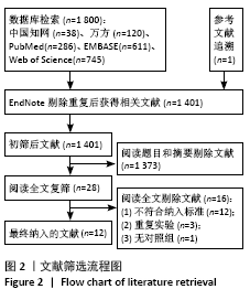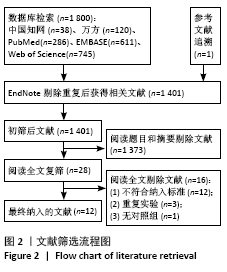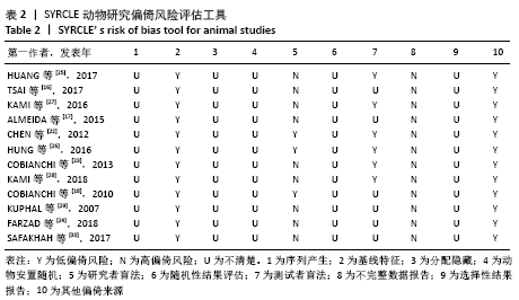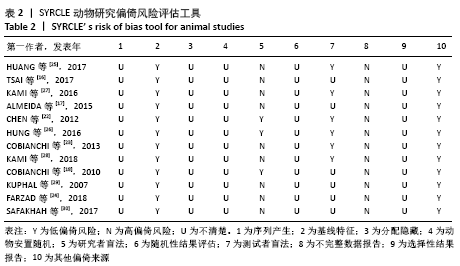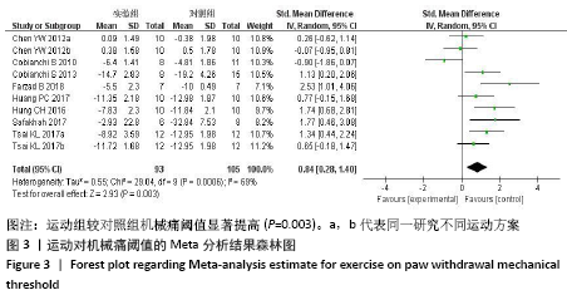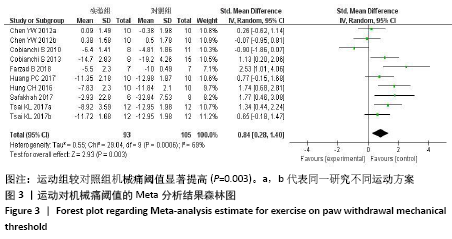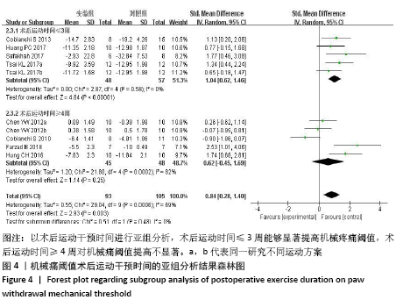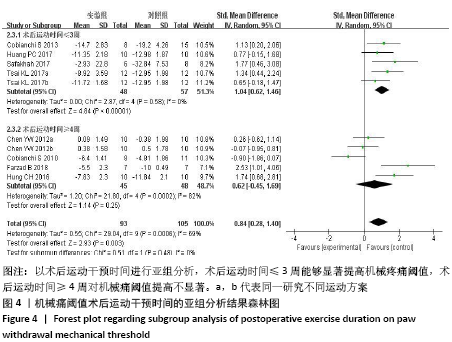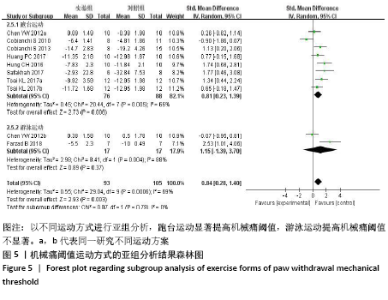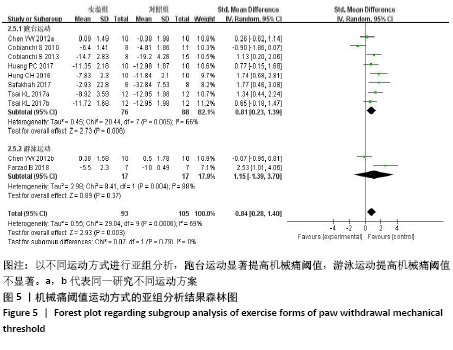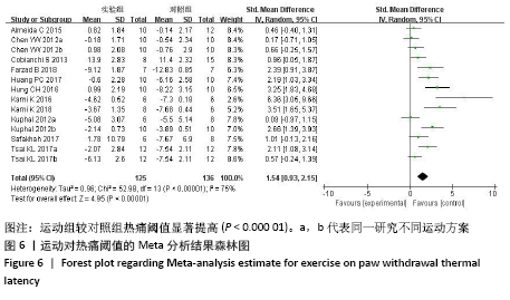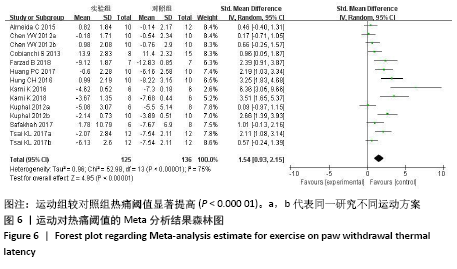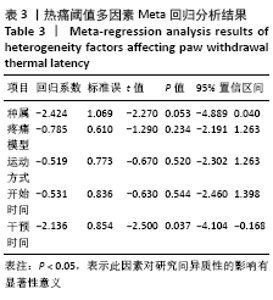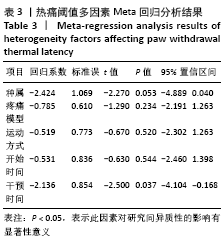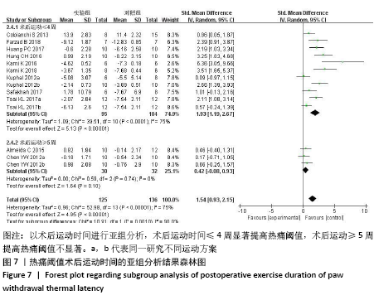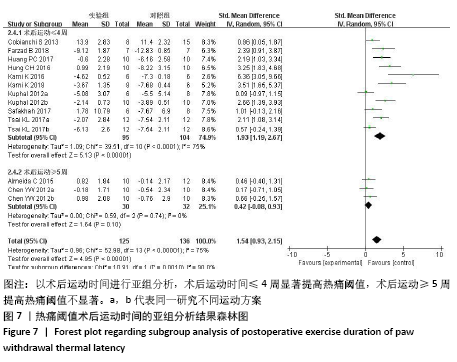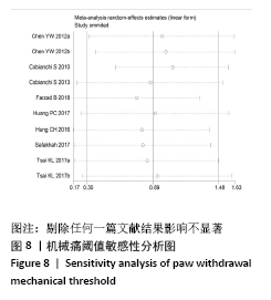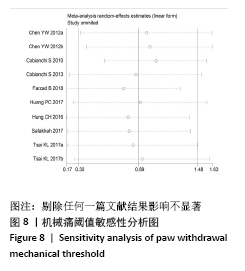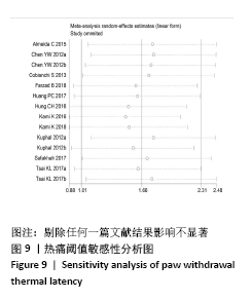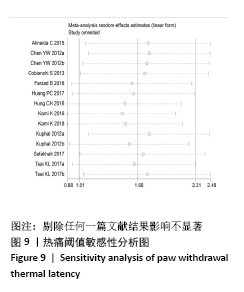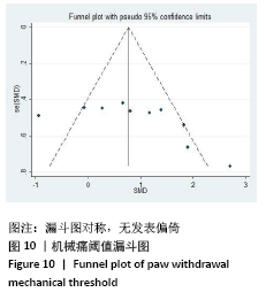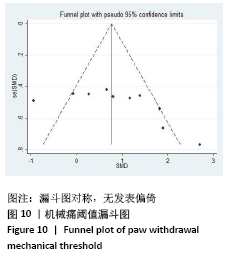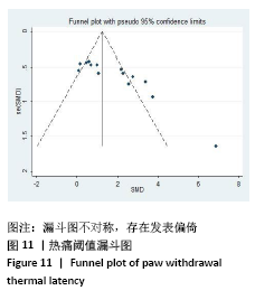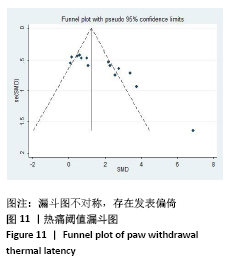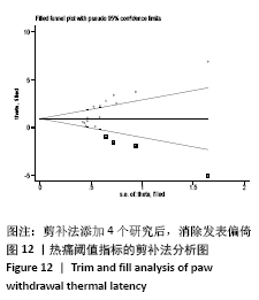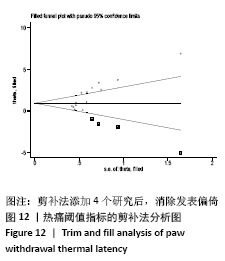Chinese Journal of Tissue Engineering Research ›› 2022, Vol. 26 ›› Issue (2): 321-328.doi: 10.12307/2022.052
Exercise improves pain induced by sciatic nerve injury in animal models: a Meta-analysis
Sun Xinzheng1, Chen Xiaoke1, Wang Chenghao1, He Hui2
- 1College of Human Sport Science, 2China Institute of Sports and Health, Beijing Sport University, Beijing 100084, China
-
Received:2020-11-12Revised:2020-11-14Accepted:2020-12-07Online:2022-01-18Published:2021-10-28 -
Contact:He Hui, MD, China Institute of Sports and Health, Beijing Sport University, Beijing 100084, China -
About author:Sun Xinzheng, Master candidate, College of Human Sport Science, Beijing Sport University, Beijing 100084, China -
Supported by:the Fundamental Research Funds for the Central Universities, No. 2020036 (to HH)
CLC Number:
Cite this article
Sun Xinzheng, Chen Xiaoke, Wang Chenghao, He Hui. Exercise improves pain induced by sciatic nerve injury in animal models: a Meta-analysis[J]. Chinese Journal of Tissue Engineering Research, 2022, 26(2): 321-328.
share this article
Add to citation manager EndNote|Reference Manager|ProCite|BibTeX|RefWorks
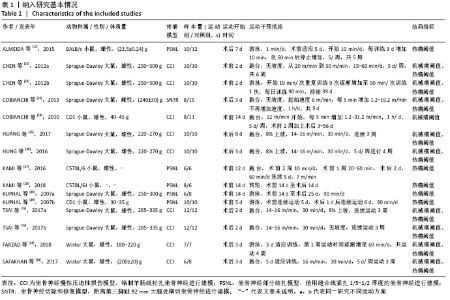
2.2 纳入研究的基本特征 共纳入12篇对照动物实验文献[16-18,22-30]。其中3篇文献使用2种运动方案[16,22,29],共15个运动方案。研究对象的样本量为大鼠(68.9%)和小鼠(31.1%),运动组133只鼠,对照组147只鼠。纳入研究采用的疼痛模型包括坐骨神经部分结扎模型、坐骨神经慢性压迫性损伤模型和坐骨神经切除和修复模型。纳入的运动方案,有9个研究采用跑台运动[16,18,22-23,25-27],其中3个研究使用8%的坡度[16,25-26],5个研究采用游泳运动方案[17,22,24,29],1个研究使用自愿转轮运动方案[28],7个研究术前开始正式运动干预[18,22,27-29],7个研究术后开始正式运动干预[16-17,23-26,30]。术后运动干预时长最短为1周[23],最长为8周[18],无不良反应。对照组与运动组建造同样的疼痛模型,对照组不进行运动干预。由于运动对冷痛敏和自发痛的研究较少,文章主要研究运动对机械痛觉敏和热痛觉敏的治疗效果。为保证研究之间较好的同质性,纳入的结局指标均为Von Fery filaments测量的机械痛阈值和热辐射测量的热痛阈值,见表1。 "
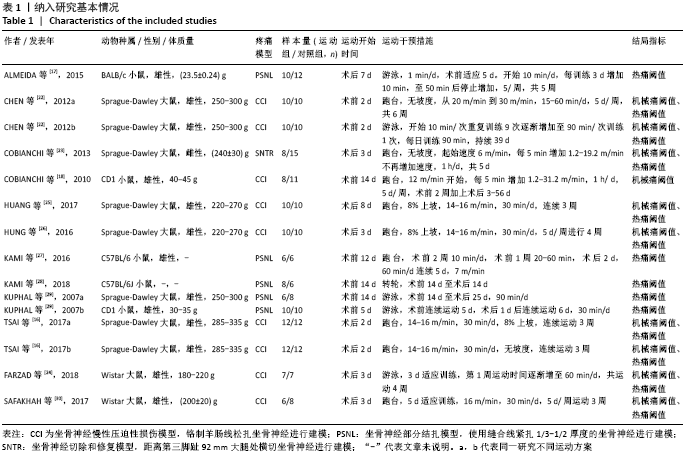
| [1] Sá KN, MOREIRA L, BAPTISTA AF, et al. Prevalence of chronic pain in developing countries: systematic review and meta-analysis. Pain Rep. 2019;4:e779. [2] BREIVIK H, COLLETT B, VENTAFRIDDA V, et al. Survey of chronic pain in Europe: prevalence, impact on daily life, and treatment. Eur J Pain. 2006;10:287. [3] ZHOU W, JIN Y, MENG Q, et al. A neural circuit for comorbid depressive symptoms in chronic pain. Nat Neurosci. 2019;22:1649. [4] GOLDBERG DS, MCGEE SJ. Pain as a global public health priority. BMC public health. 2011;11:770. [5] VAN HECKE O, AUSTIN SK, KHAN RA, et al. Neuropathic pain in the general population: a systematic review of epidemiological studies. Pain. 2014;155:654. [6] COHEN SP, MAO J. Neuropathic pain: mechanisms and their clinical implications. BMJ. 2014;348:f7656. [7] ATTAL N. Pharmacological treatments of neuropathic pain: the latest recommendations. Rev Neurol (Paris). 2019; 175:46. [8] HYLANDS-WHITE N, DUARTE RV, RAPHAEL JH. An overview of treatment approaches for chronic pain management. Rheumatol Int. 2017;37:29. [9] 孙宁,张娜,林璐璐,等.针刺改善慢性疼痛患者情绪障碍的Meta分析[J].中国针灸,2020,40(6):657-663. [10] 邓默,赵峰.神经干细胞移植治疗坐骨神经半切断神经病理性疼痛的最佳剂量[J].中国组织工程研究,2015,19(45):7314-7319. [11] PEDERSEN BK, SALTIN B. Exercise as medicine-evidence for prescribing exercise as therapy in 26 different chronic diseases. Scand J Med Sci Sports. 2015;25 Suppl 3:1-72. [12] TERKELSEN AJ, BACH FW, JENSEN TS. Experimental forearm immobilization in humans induces cold and mechanical hyperalgesia. Anesthesiology. 2008;109: 297. [13] TRIERWEILER J, GöTTERT DN, GEHLEN G. Evaluation of mechanical allodynia in an animal immobilization model using the von frey method. J Manipulative Physiol Ther. 2012;35:18. [14] GUO JB, CHEN BL, WANG Y, et al. Meta-Analysis of the Effect of Exercise on Neuropathic Pain Induced by Peripheral Nerve Injury in Rat Models. Front Neurol. 2019;10:636. [15] 吴志伟,宋朋飞,朱清广,等.神经病理性疼痛动物模型研究进展[J].中华中医药学刊,2019,37(5):1083-1087. [16] TSAI KL, HUANG PC, WANG LK, et al. Incline treadmill exercise suppresses pain hypersensitivity associated with the modulation of pro-inflammatory cytokines and anti-inflammatory cytokine in rats with peripheral nerve injury. Neurosci Lett. 2017;643:27. [17] ALMEIDA C, DEMAMAN A, KUSUDA R, et al. Exercise therapy normalizes BDNF upregulation and glial hyperactivity in a mouse model of neuropathic pain. Pain. 2015;156:504. [18] COBIANCHI S, MARINELLI S, FLORENZANO F, et al. Short- but not long-lasting treadmill running reduces allodynia and improves functional recovery after peripheral nerve injury. Neuroscience. 2010;168:273. [19] PITCHER MH. The impact of exercise in rodent models of chronic pain. Curr Osteoporos Rep. 2018;16:344. [20] MOHER D, LIBERATI A, TETZLAFF J, et al. Preferred reporting items for systematic reviews and meta-analyses: the PRISMA statement. J Clin Epidemiol. 2009;62:1006. [21] HOOIJMANS CR, ROVERS MM, DE VRIES RBM, et al. SYRCLE’s risk of bias tool for animal studies. BMC Med Res Methodol. 2014;14:43. [22] CHEN YW, LI YT, CHEN YC, et al. Exercise training attenuates neuropathic pain and cytokine expression after chronic constriction injury of rat sciatic nerve. Anesth Analg. 2012;114:1330. [23] COBIANCHI S, CASALS-DIAZ L, JARAMILLO J, et al. Differential effects of activity dependent treatments on axonal regeneration and neuropathic pain after peripheral nerve injury. Exp Neurol. 2013; 240:157. [24] FARZAD B, RAJABI H, GHARAKHANLOU R, et al. Swimming training attenuates allodynia and hyperalgesia induced by peripheral nerve injury in an adult male rat neuropathic model: effects on irisin and GAD65. Pain Med. 2018;19:2236. [25] HUANG PC, TSAI KL, CHEN YW, et al. Exercise combined with ultrasound attenuates neuropathic pain in rats associated with downregulation of il-6 and tnf-α, but with upregulation of IL-10. Anesth Analg. 2017;124:2038. [26] HUNG CH, HUANG PC, TZENG JI, et al. Therapeutic ultrasound and treadmill training suppress peripheral nerve injury-induced pain in rats. Phys Ther. 2016;96: 1545. [27] KAMI K, TAGUCHI MS, TAJIMA F, et al. Improvements in impaired GABA and GAD65/67 production in the spinal dorsal horn contribute to exercise-induced hypoalgesia in a mouse model of neuropathic pain. Mol Pain. 2016. doi: 10.1177/1744806916629059. [28] KAMI K, TAJIMA F, SENBA E. Activation of mesolimbic reward system via laterodorsal tegmental nucleus and hypothalamus in exercise-induced hypoalgesia. Sci Rep. 2018; 8:11540. [29] KUPHAL KE, FIBUCH EE, TAYLOR BK. Extended swimming exercise reduces inflammatory and peripheral neuropathic pain in rodents. J Pain. 2007;8:989. [30] SAFAKHAH HA, MORADI KOR N, BAZARGANI A, et al. Forced exercise attenuates neuropathic pain in chronic constriction injury of male rat: an investigation of oxidative stress and inflammation. J Pain Res. 2017;10:1457. [31] GRACE PM, FABISIAK TJ, GREEN-FULGHAM SM, et al. Prior voluntary wheel running attenuates neuropathic pain. Pain. 2016; 157:2012. [32] 王群,吕岩.疼痛特异性学说与闸门控制学说:争论还在持续[J].中国疼痛医学杂志,2014,20(9):609-613. [33] 陈明,武丽娟,吴雪琼.人类Mas相关基因及其G蛋白偶联受体研究进展[J].现代生物医学进展,2016,16(35):6993-6997. [34] 张瑛,王韵.TRPV1:一种同时参与慢性痛外周敏化和疼痛中枢调制的重要分子[J].生理学报,2017,69(5):677-684. [35] CAVANAUGH DJ, LEE H, LO L, et al. Distinct subsets of unmyelinated primary sensory fibers mediate behavioral responses to noxious thermal and mechanical stimuli. Proc Natl Acad Sci U S A. 2009;106:9075. [36] 颜冰,戴文玲,刘吉华.神经病理性疼痛中神经生长因子的作用及其相关镇痛药物研发进展[J]. 药学进展,2019,43(2): 111-117. [37] CHAUMETTE T, DELAY L, BARBIER J, et al. c-Jun/p38MAPK/ASIC3 pathways specifically activated by nerve growth factor through TrkA are crucial for mechanical allodynia development. Pain. 2020;161:1109. [38] 吴志伟,宋朋飞,朱清广,等.神经病理性疼痛机制研究进展[J].河北医科大学学报,2018,39(9):1095-1100. [39] 贾书冰,赵明沂,梁露花,等.漏斗图在Meta分析中的正确使用研究[J].数理医药学杂志,2013,26(4):402-405. [40] LI WC, GAO G, LUN ZJ, et al. Proceedings of 2018 5th International Symposium on Computer, Communication, Control and Automation (3CA 2018). Information Engineering Research Institute, USA. Singapore Management and Sports Science Institute, Singapore, 2018. [41] MOGIL JS. Sex differences in pain and pain inhibition: multiple explanations of a controversial phenomenon. Nat Rev Neurosci. 2012;13:859. |
| [1] | Tan Xinfang, Guo Yanxing, Qin Xiaofei, Zhang Binqing, Zhao Dongliang, Pan Kunkun, Li Yuzhuo, Chen Haoyu. Effect of uniaxial fatigue exercise on patellofemoral cartilage injury in a rabbit [J]. Chinese Journal of Tissue Engineering Research, 2022, 26(在线): 1-6. |
| [2] | Wu Min, Zhang Yeting, Wang Lu, Wang Junwei, Jin Yu, Shan Jixin, Bai Bingyi, Yuan Qiongjia. Effect of concurrent training sequences on body composition and hormone response: a Meta-analysis [J]. Chinese Journal of Tissue Engineering Research, 2022, 26(8): 1305-1312. |
| [3] | Gu Zhengqiu, Xu Fei, Wei Jia, Zou Yongdi, Wang Xiaolu, Li Yongming. Exploratory study on talk test as a measure of intensity in blood flow restriction training [J]. Chinese Journal of Tissue Engineering Research, 2022, 26(8): 1154-1159. |
| [4] | Kan Houming, Fan Lijun, Chen Xuetai, Shen Wen. Application of platelet-rich plasma in neuropathic pain [J]. Chinese Journal of Tissue Engineering Research, 2022, 26(8): 1286-1292. |
| [5] | Shui Xiaoping, Li Chunying, Li Shunchang, Sun Junzhi, Su Quansheng . Effects of aerobic and resistance exercises on brain-derived neurotrophic factor, nuclear factor-kappa B and inflammatory cytokines in skeletal muscle of type II diabetic rats [J]. Chinese Journal of Tissue Engineering Research, 2022, 26(5): 669-675. |
| [6] | Deng Shuang, Pu Rui, Chen Ziyang, Zhang Jianchao, Yuan Lingyan . Effects of exercise preconditioning on myocardial protection and apoptosis in a mouse model of myocardial remodeling due to early stress overload [J]. Chinese Journal of Tissue Engineering Research, 2022, 26(5): 717-723. |
| [7] | Mo Weibin, Huang Tianchang, Zeng Zhiwei, Yan Linbo. Effects of Pueraria lobata flavonoids on expressions of beta-catenin and glycogen synthase kinase 3beta in the brain of rats undergoing exhaustive exercise after long endurance exercise [J]. Chinese Journal of Tissue Engineering Research, 2022, 26(5): 736-741. |
| [8] | Wei Xing, Liu Shufang, Mao Ning. Roles and values of blood flow restriction training in the rehabilitation of knee joint diseases [J]. Chinese Journal of Tissue Engineering Research, 2022, 26(5): 774-779. |
| [9] | Tang Jiping, Zhang Yeting. Exercise regulates adult hippocampal neurogenesis in Alzheimer’s disease: mechanism and role [J]. Chinese Journal of Tissue Engineering Research, 2022, 26(5): 798-803. |
| [10] | Liu Yiyi, Qiu Junqiang, Yi Longyan, Zhou Cailiang. Effect of resistance training on interleukin-6 and C-reactive protein in middle-age and elderly people: a Meta-analysis [J]. Chinese Journal of Tissue Engineering Research, 2022, 26(5): 804-812. |
| [11] | Geng Yuanwen, Lin Qinqin, Li Ruoming, Tang Shaokai, Wang Baihui, Tian Zhenjun. A single bout of exhaustive exercise induces renal NOD-like receptor protein 3 inflammasome expression in rats [J]. Chinese Journal of Tissue Engineering Research, 2022, 26(2): 190-196. |
| [12] | Zeng Xinyu, Chen Xianghe, Liu Bo, Lu Pengcheng, Jin Shengjie, Li Wenxiu, Tian Zhikai, Sun Changliang. Mechanism of exercise improving bone metabolism in type 2 diabetics mellitus based on "Muscle-Bone" Crosstalk [J]. Chinese Journal of Tissue Engineering Research, 2022, 26(2): 289-295. |
| [13] | Kan Jie. Guidelines for exercise during pregnancy in developed countries and revelation for the Healthy China Action [J]. Chinese Journal of Tissue Engineering Research, 2022, 26(2): 308-314. |
| [14] | Jia Ruizhen, Jiang Chao, Jin Qiguan, Lou Xujia, Hu Yulong. Effects and mechanism of the combined use of L-carnitine, pantothenic acid and coenzyme Q10 on aerobic exercise-induced fatigue in mice [J]. Chinese Journal of Tissue Engineering Research, 2022, 26(2): 165-170. |
| [15] | Shen Jinbo, Zhang Lin. Micro-injury of the Achilles tendon caused by acute exhaustive exercise in rats: ultrastructural changes and mechanism [J]. Chinese Journal of Tissue Engineering Research, 2021, 25(8): 1190-1195. |
| Viewed | ||||||
|
Full text |
|
|||||
|
Abstract |
|
|||||
